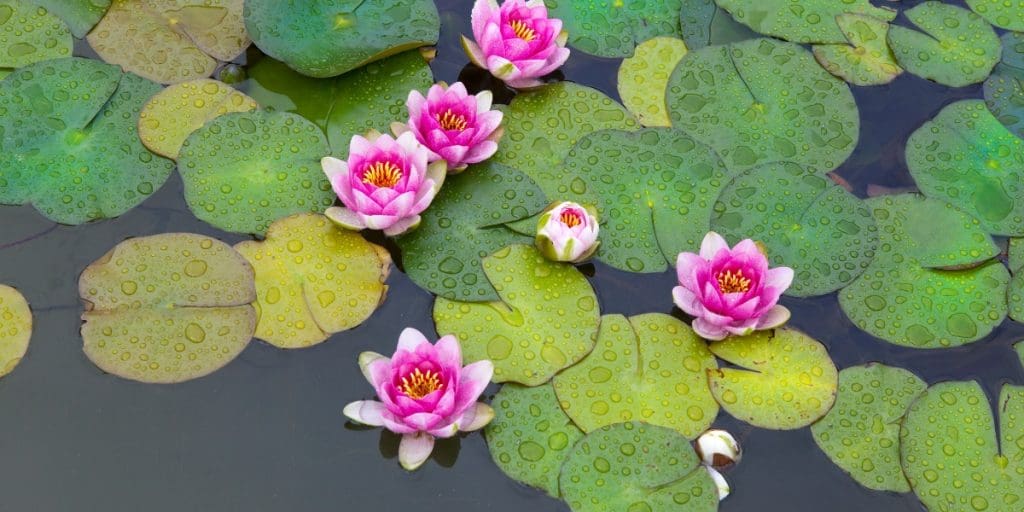Adding plants to your koi pond is a great way to enhance its beauty and provide a more natural habitat for your fish. However, you may be wondering how to add plants to a koi pond with no shallow water, and without damaging them or your pond’s ecosystem. Fortunately, there are several options available to you.
One option is to use cinder blocks or other masonry to create a platform for your plants. This allows you to place the plants at the desired depth without disturbing the bottom of your pond. Another option is to use floating plants, which sit atop the water’s surface and require no planting. Additionally, you can use planters to hold your plants and place them at the desired depth without disturbing the pond’s bottom.
Main Points
Adding plants to your koi pond can provide numerous benefits, including improving water quality, providing natural shade, shelter, and food for koi fish. It can be challenging figuring out how to add plants to a koi pond with no shallow water. Here are some main points to keep in mind when adding plants to a koi pond with no shallow water:
All in all, adding plants to a koi pond with no shallow water is possible, but it requires careful selection, planting, and maintenance. By following these main points, you can create a healthy and beautiful ecosystem for your koi fish to thrive.


Understanding Koi Ponds
If you’re planning to add plants to your koi pond, it’s important to understand the characteristics of a koi pond and the role of shallow water in it.
Characteristics of Koi Ponds
Koi ponds are specifically designed to house koi fish, which are known for their vibrant colors and patterns. These ponds are typically deeper than regular garden ponds, with a depth of at least 3 feet. This is because koi fish need a lot of space to swim and grow, and they also produce a lot of waste.
Koi ponds also have a different filtration system than regular ponds. They require a biological filter that can handle the high levels of ammonia and nitrites produced by the fish. This filter helps to maintain the water quality in the pond and keep the fish healthy.
Importance of Shallow Water
While koi ponds are deeper than regular ponds, they still require shallow areas for a variety of reasons. One of the main reasons is that shallow water provides a habitat for beneficial bacteria that help to break down waste and maintain water quality. These bacteria thrive in shallow water where there is plenty of oxygen and sunlight.
Shallow water also provides a place for plants to grow. Plants play an important role in koi ponds by providing oxygen, absorbing nutrients, and helping to filter the water. They also provide shade and shelter for the fish, which can reduce stress and improve their overall health.
If your koi pond doesn’t have any shallow areas, you can still add plants by using floating plants or plants that can grow in deeper water. Water lilies and water hyacinths are popular choices for koi ponds and can grow in water that is at least 6 inches deep. Just be sure to choose plants that are compatible with koi fish and won’t be eaten or uprooted by them.
Overall, understanding the characteristics of a koi pond and the importance of shallow water is essential if you want to add plants to your pond. By providing a habitat for beneficial bacteria and plants, you can help to maintain water quality and improve the health of your koi fish.


Challenges in Adding Plants to Deep Water Koi Ponds
Lack of Shallow Water
If you have a deep water koi pond, one of the biggest challenges you may face in adding plants is the lack of shallow water. Most aquatic plants require shallow water to root and grow properly. Without shallow water, it can be difficult to provide the necessary conditions for plant growth.
One solution to this problem is to create a shallow area in your pond. You can do this by building a shelf or using rocks to create a sloping area. This will provide the necessary conditions for plants to root and grow, while still maintaining the depth of your pond.
Plant Survival in Deep Water
Another challenge in adding plants to a deep water koi pond is ensuring their survival. Plants that are not suited to deep water may struggle to survive in your pond. This can be due to a lack of sunlight, poor water quality, or simply the depth of the water.
To ensure the survival of your plants, it is important to choose species that are well-suited to deep water. Look for plants that are known to thrive in deep water environments. You may also need to provide additional lighting or nutrients to help your plants grow and thrive.
Overall, adding plants to a deep water koi pond can be challenging, but it is not impossible. With the right approach and a bit of patience, you can create a beautiful and thriving ecosystem in your pond.
Choosing the Right Plants


When it comes to adding plants to a koi pond without shallow water, it’s important to choose the right plants that will thrive in deeper water. In this section, we’ll discuss the criteria for selecting plants and recommend some plants that are suitable for deep water koi ponds.
Criteria for Selecting Plants
When choosing plants for a deep water koi pond, there are a few criteria to keep in mind:
- Water Depth: Since a deep water koi pond lacks shallow areas, it’s important to choose plants that can survive in deeper water.
- Hardiness: Make sure the plants you choose are hardy and can withstand the water temperature and other conditions in your pond.
- Compatibility: Some plants may not be compatible with koi fish, so it’s important to choose plants that won’t harm your fish.
- Maintenance: Consider the amount of maintenance required for each plant and choose plants that fit your level of commitment.
Recommended Plants for Deep Water Koi Ponds
Here are some plants that are recommended for deep water koi ponds:
| Plant Name | Description |
|---|---|
| Water Lilies (Nymphaeaceae) | These plants have large, floating leaves that provide shade for koi and help to oxygenate the water. They also produce beautiful flowers in a variety of colors. |
| Hornwort (Ceratophyllum demersum) | This submerged plant is easy to care for and helps to oxygenate the water. It also provides cover for koi fish and helps to prevent algae growth. |
| Anacharis (Elodea canadensis) | Another submerged plant, anacharis is hardy and easy to care for. It helps to oxygenate the water and provides cover for koi fish. |
| Water Hyacinth (Eichhornia crassipes) | This floating plant has beautiful purple flowers and helps to absorb excess nutrients from the water. It also provides shade for koi fish. |
| Water Lotus (Nelumbo nucifera) | The water lotus is an aquatic plant with large, floating leaves and fragrant, colorful flowers. It thrives in deeper, sunny ponds and is relatively easy to care for. |
Remember to research each plant thoroughly before adding it to your koi pond. With the right plants, you can create a beautiful and healthy ecosystem for your koi fish.


Methods for Adding Plants to Deep Water Koi Ponds
If you have a koi pond with no shallow water, you may think that adding plants is not possible. However, there are several methods you can use to add plants to deep water koi ponds. Here are three effective methods:
Using Floating Planters
Floating planters are a great option for adding plants to deep water koi ponds. These planters are designed to float on the surface of the water, allowing plants to grow in them while still being submerged. Floating planters come in various shapes and sizes, and they can be used to grow a wide variety of aquatic plants.
To use floating planters, simply fill them with soil and plant your chosen aquatic plants. Then, place the planters in the pond, making sure they are anchored in place to prevent them from floating away. Floating planters are an excellent option for adding color and texture to your koi pond.
Employing Water Plant Baskets
Water plant baskets are another effective way to add plants to deep water koi ponds. These baskets are designed to hold soil and plants, and they can be submerged in the water to allow plants to grow. Water plant baskets come in various sizes and shapes, and they can be used to grow a variety of aquatic plants.
To use water plant baskets, fill them with soil and plant your chosen aquatic plants. Then, submerge the baskets in the pond, making sure they are anchored in place to prevent them from floating away. Water plant baskets are an excellent option for adding a natural look to your koi pond.


Implementing Pond Planting Bags
Pond planting bags are a third option for adding plants to deep water koi ponds. These bags are designed to hold soil and plants, and they can be placed on the bottom of the pond to allow plants to grow. Pond planting bags come in various sizes, and they can be used to grow a variety of aquatic plants.
To use pond planting bags, fill them with soil and plant your chosen aquatic plants. Then, place the bags on the bottom of the pond, making sure they are anchored in place to prevent them from moving around. Pond planting bags are an excellent option for adding a natural look to your koi pond while also providing a habitat for fish and other aquatic creatures.
Overall, there are several effective methods for adding plants to deep water koi ponds. Whether you choose floating planters, water plant baskets, or pond planting bags, adding plants to your koi pond can enhance its beauty and provide a natural habitat for your fish.
Stacking Bricks or Cinder Blocks
For ponds that are too deep for regular plant placement, one can stack bricks or cinder blocks in the water. This creates an elevated platform within the pond. Once the bricks or blocks are securely stacked to the desired height, plant pots can be placed on top of these stacks. This method allows the plants to be positioned closer to the water’s surface, ensuring they receive adequate sunlight and are within reach for maintenance.
Additionally, using bricks or cinder blocks provides stability against strong water currents and prevents the plants from being uprooted by fish or other aquatic animals. The porous nature of cinder blocks can also serve as a habitat for beneficial bacteria, aiding in the biological filtration of the pond and contributing to a healthier aquatic environment.


Maintaining Plants in a Koi Pond
Adding plants to your koi pond can enhance its beauty and provide a natural habitat for your fish. However, if your pond has no shallow water, you may wonder how to maintain plants. In this section, we will discuss routine care and handling plant diseases to help you maintain healthy and thriving plants in your koi pond.
Routine Care
Routine care is essential to maintain healthy plants in your koi pond. Here are some tips to keep in mind:
- Water Quality: Ensure that the water quality of your pond is optimal. Poor water quality can lead to algae growth and harm your plants.
- Fertilization: Fertilize your plants regularly to promote healthy growth. However, be careful not to over-fertilize, as it can lead to algae growth and harm your fish.
- Pruning: Regularly prune your plants to remove dead leaves and promote new growth. This will also prevent overcrowding and ensure that your plants receive enough sunlight.
- Placement: Choose plants that can thrive in deeper water and place them in areas with enough sunlight. You can also use floating plants that do not require planting.
Handling Plant Diseases
Plant diseases can be a challenge to handle in a koi pond. Here are some tips to help you manage plant diseases:
- Identification: Identify the type of disease affecting your plants. This will help you choose the appropriate treatment.
- Treatment: Use an appropriate treatment to manage the disease. You can use natural remedies or chemical treatments, depending on the severity of the disease.
- Prevention: Prevent the spread of disease by removing infected plants and maintaining good water quality.
By following these routine care tips and handling plant diseases, you can maintain healthy and thriving plants in your koi pond.
Final Thoughts


Adding plants to your koi pond is a great way to enhance its beauty and improve the overall health of your fish. While adding plants to a pond with no shallow water may seem challenging, there are still plenty of options available to you.
Floating plants like water hyacinths and water lettuce are easy to maintain and can be overwintered or treated as annuals. Water lilies and lotus plants can also be added to your pond, but they require a little more effort to plant and maintain.
When choosing plants for your koi pond, make sure to select ones that are suitable for aquatic environments. Some plants, like cattails, can grow in less water or marshy soil. Others, like dwarf papyrus, require shallow water to thrive.
It’s important to remember that while plants can provide natural shade, shelter, and food for your koi fish, they can also be a tasty treat for them. To prevent your fish from eating all of your plants, consider installing netting systems or planting other delicious but less visually appealing plants nearby.
Overall, adding plants to your koi pond can be a rewarding and enjoyable experience. With a little research and planning, you can create a beautiful and healthy environment for your fish to thrive in.


JOIN OUR COMMUNITY AND GET A FREE E-BOOK
Frequently Asked Questions
What are some live water plants that are safe for koi and can be added to a deep pond?
Water lilies, lotus plants, and water hyacinths are some safe water plants for koi that can be added to a deep pond. These plants offer shade, food, and shelter for koi fish. They also help balance the ecosystem and improve water quality.
How can I protect water lilies in my koi pond from being eaten by the fish?
You can protect water lilies in your koi pond by adding a barrier around the plants. You can use a mesh or a plastic fence to keep the koi away from the plants. You can also add rocks or stones around the plants to prevent the koi from digging them up.
Are there any plant protectors available for koi ponds?
Yes, there are plant protectors available for koi ponds. You can use plant protectors made of plastic, metal, or mesh to keep the koi away from the plants. These protectors are easy to install and can be removed when the plants grow bigger.
What are some non-edible plants that can be added to a koi pond?
Non-edible plants such as water ferns, hornwort, and anacharis can be added to a koi pond. These plants provide oxygen to the water and help improve the water quality. They also offer shade and shelter for the koi fish.
Can Pothos be added to a koi pond?
Yes, pothos can be added to a koi pond. Pothos is a non-aquatic plant that can grow roots in water. It helps absorb excess nutrients and pollutants from the water, improving water quality. However, you need to keep the plant in a pot and not let it spread too much in the pond.
What are some tips for adding aquatic plants to a deep koi pond?
When adding aquatic plants to a deep koi pond, make sure to choose plants that can tolerate deep water. You can add a mix of floating, submerged, and marginal plants to create a balanced ecosystem. Be sure to plant the plants in pots with a heavy substrate to prevent them from floating up. Also, avoid adding too many plants as they can compete with each other for nutrients and sunlight.
 1 (509) 228-8646
1 (509) 228-8646



